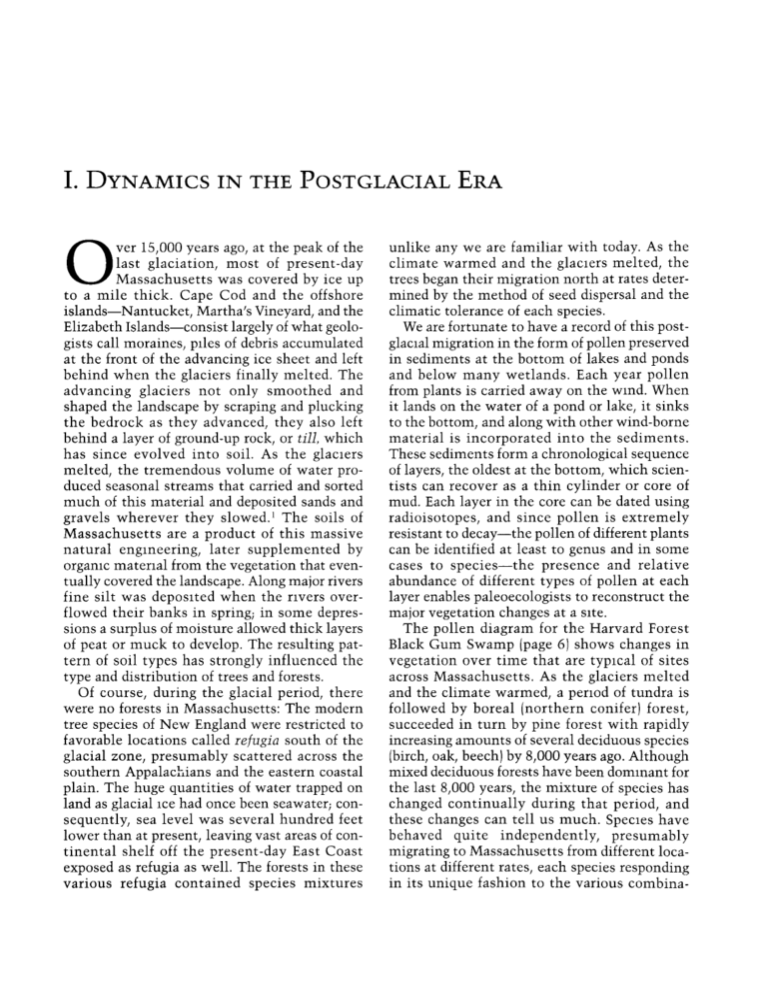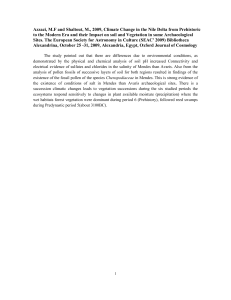Dynamics in the Postglacial Era
advertisement

1. DYNAMICS IN THE ver 15,000 years ago, at the t most POSTGLACIAL ERA peak of the of present-day glaciation, was covered by ice up to a mile thick. Cape Cod and the offshore islands-Nantucket, Martha’s Vineyard, and the Elizabeth Islands-consist largely of what geologists call moraines, piles of debris accumulated at the front of the advancing ice sheet and left behind when the glaciers finally melted. The advancing glaciers not only smoothed and shaped the landscape by scraping and plucking the bedrock as they advanced, they also left behind a layer of ground-up rock, or till, which has since evolved into soil. As the glaciers melted, the tremendous volume of water produced seasonal streams that carried and sorted much of this material and deposited sands and gravels wherever they slowed.’ The soils of Massachusetts are a product of this massive natural engineering, later supplemented by orgamc material from the vegetation that eventually covered the landscape. Along major rivers fine silt was deposited when the rivers overflowed their banks in spring; in some depressions a surplus of moisture allowed thick layers of peat or muck to develop. The resulting pattern of soil types has strongly influenced the type and distribution of trees and forests. Of course, during the glacial period, there were no forests in Massachusetts: The modern tree species of New England were restricted to favorable locations called refugia south of the glacial zone, presumably scattered across the southern Appalac ~ians and the eastern coastal plain. The huge quantities of water trapped on land as glacial ice had once been seawater; consequently, sea level was several hundred feet lower than at present, leaving vast areas of continental shelf off the present-day East Coast exposed as refugia as well. The forests in these various refugia contained species mixtures last Massachusetts unlike any we are familiar with today. As the climate warmed and the glaciers melted, the trees began their migration north at rates determined by the method of seed dispersal and the climatic tolerance of each species. We are fortunate to have a record of this postglacial migration in the form of pollen preserved in sediments at the bottom of lakes and ponds and below many wetlands. Each year pollen from plants is carried away on the wmd. When it lands on the water of a pond or lake, it sinks to the bottom, and along with other wind-borne material is incorporated into the sediments. These sediments form a chronological sequence of layers, the oldest at the bottom, which scientists can recover as a thin cylinder or core of mud. Each layer in the core can be dated using radioisotopes, and since pollen is extremely resistant to decay-the pollen of different plants can be identified at least to genus and in some cases to species-the presence and relative abundance of different types of pollen at each layer enables paleoecologists to reconstruct the major vegetation changes at a site. The pollen diagram for the Harvard Forest Black Gum Swamp (page 6) shows changes in vegetation over time that are typical of sites across Massachusetts. As the glaciers melted and the climate warmed, a period of tundra is followed by boreal (northern conifer) forest, succeeded in turn by pine forest with rapidly increasing amounts of several deciduous species (birch, oak, beech) by 8,000 years ago. Although mixed deciduous forests have been dommant for the last 8,000 years, the mixture of species has changed continually during that period, and these changes can tell us much. Species have behaved quite independently, presumably migrating to Massachusetts from different locations at different rates, each species responding in its unique fashion to the various combina- 5 Alders, bearberry, and other pioneer vegetation follow a receding glacier m Alaska. climatic, soil, biotic, and historical facfound in the area. The major influences on these changes are long-term climate change, migration rates of individual species, and natural disturbance processes. Population dynamics of selected species help us understand these processes. Hemlock increased rapidly m importance after its arrival about 9,000 years ago. A little less than 5,000 years ago, it decreased dramatically in a very short time, then slowly recovered. This sudden decline, seen in pollen records throughout the Northeast, has been attributed to a severe outbreak of insects or disease that greatly reduced hemlock populations for nearly 1,000 years. Regional pollen analyses suggest that temperatures during the period from 8,000 to 5,000 years ago were milder than those of the last 4,000 years.2 It was during this warm period that many tree species now common in Massachusetts migrated into the area, with some species tions of tors extending well north of their current ranges. At a number of sites, fire frequency, indicated by charcoal in sediment cores, was also greater than in the more recent period.3 The increase in spruce pollen over the last 2,000 to 3,000 years was probably caused by more recent cooling. All these changes in forest communities were complex: while spruce, a northern species, increased-emdently in response to gradual cooling-chestnut, a southern species, was also migrating north across Massachusetts. In fact, chestnut is the most recent arrival in the pollen record, appearing less than 3,000 years ago, much later than the other important deciduous species that occur in the region today. The Natural Environment The distribution of forest types across Massachusetts during the period preceding European settlement was controlled by the physical geography, or physiography, of the landscape; the diagram from the Black Gum Swamp at the Harvard Forest m central Massachusetts depicting the changes m the vegetation over the past 12,000 years Tundra communities were replaced by boreal forest dominated by spruce until approximately 9,200 years before present (B P.) when pine and other tree species Pollen ma~or became important. Changes m the relative abundance of species resulted from chmate change, speczes migrations, disease (hemlock declme at about 5,000 B Pand fire until 250 to 300 years B P, when European settlement resulted m major deforestation and the mcrease m agricultural weeds, herbs, and early successional species .4 underlying geology; and the frequency of distur- Taconic Mountains. The bances such ies across as windstorm and fire. Massa- chusetts, excluding Cape Cod, is roughly rectangular, 125 miles (200 km) east to west and 50 miles (80 km) north to south. Today it receives approximately 40 mches (100 cm) of precipitation annually, distributed fairly evenly throughout the year, with a mean annual temperature that ranges from a mean of several degrees Fahrenheit below freezing in January to about 70 degrees in July, and averages nearly 50 degrees over the year. Within a relatively small, compact area, Massachusetts contains six broad physiographic regions: the coastal lowlands, the central uplands, the Connecticut River valley, the Berkshire Mountains, the Berkshire valley, and the the state. geologic substrate var- Except for parts of the Con- valley, the Taconic Mountains, and the Berkshire valley, the soil is acidic, poor in nutrients, and shallow with patches of exposed bedrock. Elevation generally increases from east to west, reaching a maximum at Mt. Greylock in the Berkshires (3,487 ft [1060 m]). These are the physiographic and geological conditions that interact with climate to produce necticut River vegetation ecoregions. zones sometimes referred to as Within Massachusetts natural vegetation largely determined by climate, which in general varies with elevation except in areas near the moderating influence of the ocean. Southeastern Massachusetts, all of Cape Cod, zones are 7 forests of the central Appalachians and the Middle Atlantic States. North and west of the central hardwood zone we generally find the transition hardwood zone, which also extends up the major river valleys in the western part of the state. This zone is characterized by increasing amounts of species found farther north, such as yellow birch, black (or sweet) birch, sugar maple, and beech, with less oak (especially white oak) and with paper birch occurring on heavily disturbed sites. The higher elevations in the Berkshire and Taconic mountains and the extreme northern border of central Massachusetts fall within the northern hardwood and spruce-fir zones. The spruce-fir zone, m which red spruce is the dominant conifer, is restricted to the highest elevations, generally above 2,000 feet, while the northern hardwood zone occurs just below the spruce-fir zone and has hemlock and white pine as its dominant conifers. Both zones have mixtures of hardwoods dominated by sugar maple, yellow birch, beech, and red maple. hickory dominated Map of southern England depicting the maior From east to west they are coastal lowlands, central uplands, Connecticut River valley, Berkshire Mountams, Berkshire valley, New physiographic regions. and Tacomc Mountams.sb6 and the offshore islands fall within the pitch pine-oak zone. This vegetation type, occurring on sandy and gravelly soils laid down as glacial moraines or outwash deposits, is characterized by drought-tolerant and fire- adapted species, including pitch pine, scrub oak, and huckleThis type also occurs scattered outwash deposits in inland Massachusetts. The remainder of the coastal lowlands, the southern central uplands, and the southern Connecticut River valley fall withm the central hardwoodhemlock-white pme zone. This vegetation type represents the northern extension of the oak- berry. on The ma~or forest vegetation zones m southern New England. Sandy glacial deposits, found on Cape Cod and m extreme southeastern Massachusetts, support a dry forest of pitch pine and scrub oak Transition hardwood forest dominates the central uplands and much of the Connecticut River and Berkshire valleys, with northern hardwood forest on the higher elevauons m the Berkshires and Tacomcs and sprucefir forest on the highest e~evatjons ~I




